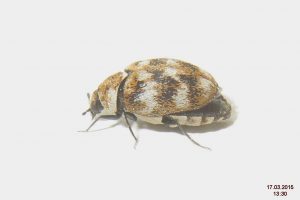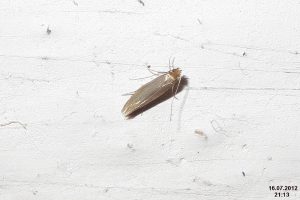Conservation Resources
In February of 2013, Megan O’Connor to our part-time staff temporarily for the summer. She has a Master’s Degree in Museum Studies from the University of Toronto and has done internships at the National Gallery of Art in Washington DC and at the Royal Ontario Museum. She has also done a diploma program in conservation [how to protect, preserve and repair vulnerable artifacts] and then did an internship with the Royal Albert Memorial Museum in the UK.
We made full use of her while she was with us and had her do a conservation ‘advice’ column for our newsletter on how to preserve your precious family heirlooms. We have assembled them here.
INSECT PESTS
Insect pests are a risk factor for the special heritage objects in your home. They tend to attack objects that contain fur, hair, feathers, wool, silk, paper and wood, for example, clothing, furniture, carpets, wooden objects, paper and photographs.
Common insects such as carpet beetles and clothes moths eat proteins like wool and silk, while silverfish aim for the glue and ink on paper and are known to damage wall paper, labels, postage stamps and paper money.
You can avoid a disastrous insect outbreak by implementing a few easy preventive measures. Insects need warmth and humidity to thrive, so keep your artifacts at a cool temperature between 18-22°C in a dry area. Avoid basements and attics as unstable temperatures their usual high moisture levels promote insect activity. Insects thrive in areas that are dusty and dirty, so maintain a clean storage and display area. Avoid placing heritage artifacts in the kitchen, as there are ample food sources in that area of the home.
Inspect your historic items for pest damage regularly, evidence of insect activity can be found in the form of holes and areas of loss on the surface of objects, frass (insect droppings, resembles dust), and dead insects casings.
If you suspect that an object is infested isolate it immediately to prevent the spread of an infestation. Place the object on a sheet of while paper in a ziplock bag in a cool, dry place away from the rest of your collection for several weeks. Monitor the object for insect activity, checking the paper for fallen casings and frass. If insect activity is detected keep object isolated during at least a summer season to minimize the risk of infestation.
PRESERVING YOUR HERITAGE ARTIFACTS: LIGHT DAMAGE
We all possess objects of special significance, for example family heirlooms, vintage clothing, or a beautiful painting. There are a few simple precautions you can implement to ensure that your treasures stay in great condition. Light is one of the main causes of artifact deterioration. Light damage is irreversible, but there are ways to prevent damage and prolong the life of your heritage artifacts.
Objects made of organic materials are the most susceptible to light, such as paper, textiles, wood, and works of art. Fading, loss of strength, and brittleness are all symptoms of light damage. Place objects away from direct light sources, such as windows and fluorescent or incandescent lights, where light levels are lower. Consider rotating the objects you have on display in your home so they aren’t exposed to light for prolonged periods. Place objects that appear to have light damage in a covered box or drawer, as excessive handling may cause unnecessary damage to weak objects.
These simple precautions will help keep your heritage artifacts looking great for years to come.
PRESERVING PHOTOGRAPHS
An artifact that is common across almost all households these days are historic photographs.
The most common types of historic photographs found in family collections are silver gelatin (black and white) prints popular from the 1890’s and still produced today, and chromogenic colour prints popular from the 1940’s. Both of these types of prints tend to deteriorate in a characteristic way. Silver gelatin prints contain silver molecules that can migrate over time towards the surface of the image, producing a mirroring affect. This shiny-metallic appearance tends to concentrate in darker areas, such as shadows. Silver-gelatin prints also tend to yellow and lose their highlights over time. Chromogenic colour prints contain three dyes that interact to produce colour images: Cyan, Magenta and Yellow. These dyes are inherently unstable and will change and fade. Cyan tends to deteriorate first leaving a yellow or red tinged to photographs. The above are all examples of chemical deterioration resulting from reactions that are almost impossible to halt or reverse, but chemical reactions can be slowed down by minimizing exposure to heat, moisture, and light. Keeping your historic photographs in a cool (no attics), dry (no basements), and dark (in a box) environment will do wonders to prolong the life of your special moments captured on film.
Often photographs are kept in frames, albums or scrapbooks for long periods of time. Popular in the 1970’s and 1980’s are photo albums with sticky or magnetic pages. These albums can be very detrimental to photographs as the chemicals in the adhesive can interact with the image layer and cause it to discolour or stain. The image layer may also stick to adhesives on the album and peel off when you attempt to remove photos. Archival quality albums where photos slide in and out of the page are the best option for long term preservation. When framing photographs make sure there is a gap between the glass and the image layer, for example use matte board for framing works of art, so the image layer doesn’t stick to the glass. When scrapbooking tape or other adhesives are not recommended for use directly on photographic prints, consider investing in self-adhesive photo corners to hold photographs in place. These can be purchased at most craft supply stores. When shopping for photograph display and storage supplies look for features like acid-free, archival quality, or inert, these supplies may be a bit more expensive but they will help your photos last for many generations to appreciate. For further information on identifying and caring for historic photographs visit the Graphics Atlas, created by the Image Permanence Institute.
PRESERVING YOUR HERITAGE ARTIFACTS: TEMPERATURE
Extreme fluctuations in temperature can be very detrimental to your heritage artifacts. There are a few key concepts to remember when considering the best temperature at which to store your heritage artifacts.
The most beneficial environment is a cool, dry place with a stable temperature of 18-22°C. Avoid rapid changes in temperature as this is very stressful for objects, especially those made of organic material. Temperature is related to moisture in the air, and as temperature changes moisture content in the air changes. Most organic material, for example wood, textiles and paper artifacts readily take on and release moisture from the air and will shrink and expand with changing temperature which can result in cracks, tears, and general weakness. When the air is hot it can encourage objects to dry out. Keeping special objects away from heat vents and radiators as well as out of direct light sources, which is a heat source, will reduce drying out in those organic objects that are sensitive to temperature changes. Heat also encourages chemical reactions to occur at a higher pace. Therefore keeping an object at a cool, stable temperature will reduce chemical degradation such as corrosion on metals and deterioration of plastics. If objects become too cold they can freeze which causes them to become extremely brittle and sensitive to even the lightest touch.
Being mindful of the temperature at which you store your heritage artifacts can prolong their life and your enjoyment of them.
HOW TO CARE FOR TEXTILES
Here at the Maple Ridge Museum and Archives we are often asked by visitors and community members how to best care for a treasured textile item. Christening gowns, wedding dresses, table cloths, carpets, and doilies and other textiles are often found in personal collections. Historic textiles are made from a variety of materials for example plant-based fibers such as cotton and linen, or animal-based fibers, such as silk and wool. Increasingly man-made fibers such as rayon and polyesters are found in historic textiles. Each type of material has particular needs and degradation risks.
One of the most important things you can do for your textile is to keep it clean. Dust and dirt attract pests and can cause staining and disfigurement over time. A soft natural bristle brush can be used to gently sweep surface dirt and dust off the outer layers. A domestic vacuum can be an effective tool for cleaning textiles. Ensure that it is set on the lowest suction level and cover the nozzle with a netted fabric (stockings, for example), securing it with an elastic band to catch any debris. Hover the nozzle one to two inches above the textile and use a brush to direct dirt and dust into the vacuum. Storing your textile in a covered box will serve the double purpose of reducing dust accumulation as well as light damage, which can result in fading.
The above method is only effective on loose surface dirt, not on ingrained stains caused by rust, fat, oil, and grease. These stains can be very difficult to remove, and may be permanent. Reduce the risk of staining by removing all pins, keeping food products away from historic textiles, and storing the textiles in a covered box or bag. Old stains are particularly stubborn as they have had time to oxidize, meaning they have combined with oxygen in the air overtime to set and become very insoluble. Oxidized stains tend to be yellow or brown and will not be effectively removed with simple washing techniques.
It is very risky to consider washing a coloured textile without consulting a professional as many dyes are soluble in water and will run, potentially disfiguring the whole textile. Also, textiles often have metal or leather attachments, which should never come into contact with water. Historic textiles should never be put through a washing machine. Dry cleaning can be an acceptable method of cleaning your historic textile, but only if it is in very good condition. Contact your local drycleaner for further information.
If implemented properly, these simple tips will keep your historic textile looking great for the years to come.

